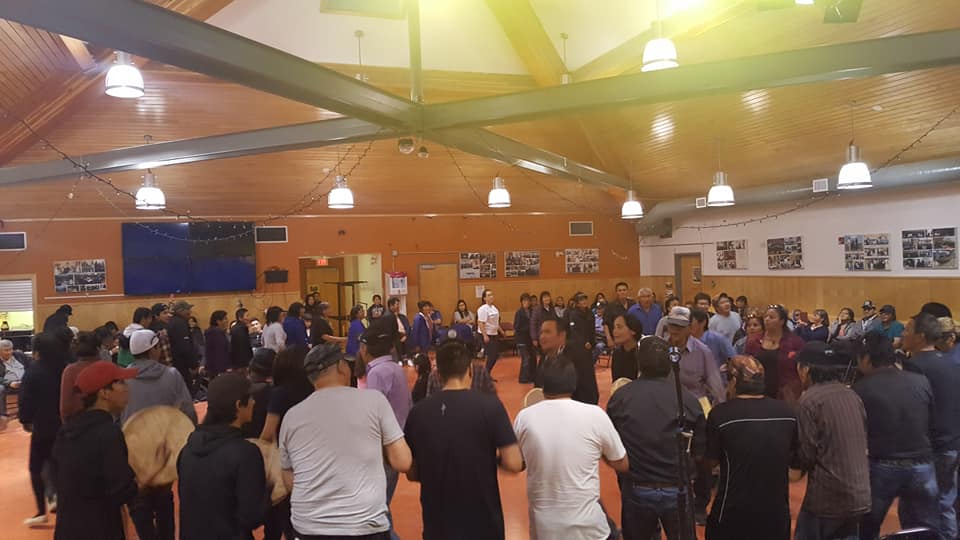School Curriculum for Arctic Youth Must Include Land Claim Agreements

Drum dance session of the Sahtu Secretariat Incorporated (SSI). Photo: The Gordon Foundation
Through a partnership with the Gordon Foundation, The Arctic Institute is publishing a series of papers on Canadian Arctic policy critiques and solutions written by Jane Glassco Northern Fellows. The Jane Glassco Northern Fellowship Program recognizes the leadership potential of northern Canadians aged 25-35 who are passionate about addressing emerging policy challenges and building a strong North. During the 18-month program, Fellows deepen their understanding of important northern issues, and develop the skills to articulate and advance their ideas and policy research. Fellows publish individual and group policy research papers. For more information, please visit The Gordon Foundation website and follow the Fellowship on Twitter.
- Turning to Traditional Processes for Supporting Mental Health
- Education Policy to Supports On-Land Learning in Northwest Territories
- Treaties, Modern Negotiation, and Indigenous Resource Management in the Canadian Arctic
- Balancing Worldviews: Climate Change Solutions in Canada’s North
- Ways Forward in Addictions Programming in the Canadian Arctic
- Indigenous Language, Community, and Legends in Post-Secondary Education
Fort Good Hope is one of five communities that make up the Sahtu Region in the Northwest Territories. The Sahtu Region signed a land claim agreement, the Sahtu Dene and Metis Comprehensive Land Claim Agreement (SDMCLCA), with the Government of Canada in 1993. From the land claim many institutions were created. The Agreement created expectations and obligations for all signing parties: The Government of Canada; the Government of the Northwest Territories; and, the Sahtu Secretariat Incorporated. With the Agreement, the Sahtu created a regional co-management system for land management and development with the territorial govern-ment. There are 29 chapters in the SDMCLCA, including enrollment, self-government, economic measures, protected areas, arbitration, and implementation.
With modern land claim agreements, First Nations in the Northwest Territories (NWT) have developed agreements beyond the historical treaties. Four regions have done this by building on Treaty 8 or Treaty 11 and negotiating a comprehensive land claim. The Inuvialuit, the Gwich’in, the Sahtu, and the Tłı̨chǫhave completed such land claim agreements. These agreements provide tools, rights, obligations, and processes for their beneficiaries, but beneficiaries may not realize their full authority.
Current rights include the inherent harvesting/traditional land use rights; requirements for community engagement and Access and Benefits Agreements for projects involving land use; resource royalties; and board appointments and representation through The Sahtu Secretariat Incorporated. Land use decisions are to be made through the Sahtu Land Use Plan, wildlife management through the Sahtu Renewable Resources Board, and resource management through the Sahtu Land and Water Board. The beneficiaries are active decision makers when it comes to issues affecting the region, such as in legislative changes, economic opportunities, and self-government.
These responsibilities offer an opportunity to define the Sahtu and its people, but each one is a complex relationship among federal, territorial, and claim governments, local leadership, and Sahtu residents. The Agreement is meant to enhance the region, but it is a recycled colonial structure, and not one created by Indingeous governance. As a result, this creates interpretation difficulties.
To continue their journey, all of the Sahtu communities (Colville Lake, Fort Good Hope, Tulita, Norman Wells, and Deline) are moving into self-government negotiations or are implementing self-government agreements. These self-government agreements are as complex as the land claims agreement, and their implementation is a new phenomenon for all communities. As in land claims agreements, the roles and responsibilities of the various organizations and the transfer of authorities from one government entity to another are not specified in the self-government agreements; they are merely contemplated.
Those responsible for implementation of the SDMCLCA—The Sahtu Secretariat Incorporated (SSI), the Government of the Northwest Territories (GNWT), and the Government of Canada (GC)—have not published an implementation report since 2014. The priorities for implementation are unclear, with three implementation meetings a year which do not result in widespread reporting. Community leaders are left to explain the roles and responsibilities of the organizations responsible for implementation but are not involved in their on-going activities. With the resources of governments, there could be more collaborative communications of shared priorities, challenges, and completed priorities.
There is a lack of school curriculum on the land claim agreements, their importance, their implementation, and the roles and responsibilities of organizations created from them. Educators are limited to their own interpretations and experiences. School programs are developed at the territorial level, and most educators are non-beneficiaries which contributes to the difficulty of exposing youth to these implementation priorities and concerns. How, then, will youth be prepared to be the next generation of decision-makers and to meet their responsibilities in the future?
Heather Bourassa is a business owner and active community member of Fort Good Hope. She attended school in Fort Good Hope, Cochrane, and at the Southern Alberta Institute of Technology in Calgary. She has been a co-owner in her family business since 2000. The business is in general contracting, primarily carrying out long-term GNWT contracts.